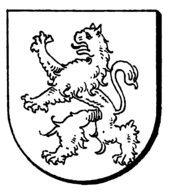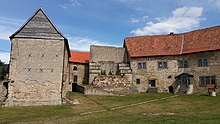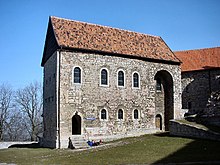County of Lohra
The County of Lohra (contemporary Lare ) was a small county in northern Thuringia that existed in the 12th and 13th centuries. It was located on the upper Wipper in the area around Bleicherode , about 15 kilometers southwest of Nordhausen . A first count was mentioned in 1116, the last count of Lohra did not return from a crusade in 1227 . Thereafter, the area continued as the rule of Lohra as part of various territories until the end of the Holy Roman Empire .
The architectural legacies of the Counts of Lohra are significant, namely Lohra Castle with its Romanesque double chapel and the Munich- Lohra monastery church .
history
Very little is known about the history of the county in documents and written sources, so that assumptions made through historiography play a major role.
founding
The history of the development of the County of Lohra is related to the Saxon War of Henry IV , which between 1073 and 1075 had a focus in northern Thuringia. The king was fighting with the greats of the region for supremacy over the areas around the Harz . The area around Lohra is located on the fork in the road of Nordhausen according Mulhouse (with ascent to the Hainleite ) and to Eichsfeld (by Eichsfelder gate in Wippertal) and thus served the kings as a connection between the imperial complexes in the resin and in Werratal to Eschwege . A first royal attempt at security by building the Hasenburg a little north of Lohra failed during the war. In order to consolidate their regional position vis-à-vis the Saxon nobility, the Salians probably established the county and gave it to relatives of the Ludowingians , who at least had no open opposition to the kings during the Saxon War. In 1116, Berengar was mentioned as the first Count of Lohra, who at that time already had a grown son and, according to the uncertain tradition of the Reinhardsbrunn Chronicles, was on his mother's side a grandson of Ludwig the Bearded from the Ludowinger family. Berengar's sister Adelheid founded the nearby Walkenried monastery in 1127 , and his younger son Dietrich I appeared in 1154 as the first count of Berka .
The new county was probably made up of both inherited Ludowingian allodies from Berengar and imperial estates and comprised the area from Worbis in the west via Bleicherode in the middle to Kleinfurra in the east and from the Hainleite in the south to the Bodetal in the north. A small ruling district with a castle was created around Großbodungen , and the Counts entrusted the ministerials of Bodungen with its administration . Lohra Castle , built around 1100 in the Hainleite above the Wippertal , became the seat of the counts . Wolfram Siegel (2005) suspects a previous count's seat, which was rededicated after the castle was built, in the area of the monastery grounds and, on the one hand, makes it accessible in analogy to the simultaneous developments in Ballenstedt / Anhalt Castle and Ermsleben / Falkenstein Castle (relocation of the aristocratic seats from the old settlements to hilltop castles ), on the other hand from the place name Lare , which (like the Hessian -lar places) stands for an enclosed area that he sees in this aristocratic seat. Excavations to confirm or refute this hypothesis have not yet been carried out in the monastery area. This contrasts with the (also uncertain) Reinhardsbrunner Chronik, which sees the origin of the Counts of Lohra among the Ludowingians, making an older seat for these counts unnecessary, as they came from outside.
Consolidation and extinction
Count Ludwig III. appeared in 1188 as Vogt von Eschwege , his younger brother Berengar II. 1184 as Vogt von Bischofstein . In the late 12th century, the good relations with the Hohenstaufen royal family ensured a high level of prosperity for the Counts of Lohra in relation to the size of the country. At the same time, the important Romanesque double chapel at Lohra Castle and the Munich- Lohra monastery church , which is also one of the most important Romanesque buildings in Thuringia, were built. The relationship between the monastery and the counts is not entirely clear. It was probably the family monastery , although no burial of one of the counts is documented there. In addition, today's monastery church comes from a women's monastery, while the place name Münchenlohra refers to a gentleman 's monastery . It is possible that before the current church was built there was a previous building of a later converted monastery, which would not have been unusual at that time. The monastery does not appear in the documentary tradition until 1289, over a century after its building-historically proven foundation, which is further evidence of the sparse written sources on the county.
Only a good 100 years after it was established, the county's independence ended with the death of Ludwig IV of Lohra on a crusade in 1227.
Continuation as rule Lohra
After the Counts of Lohra died out, the closely related Counts of Beichlingen inherited the area and occupied Lohra Castle with bailiffs for administration. Like many other smaller count families from Thuringia, they too were in decline in the mid-14th century and were forced to sell parts of their property. After the western part around Worbis had been sold to the Wettin Landgraviate of Thuringia as early as 1289 , the remaining rule of Lohra came to the directly neighboring county of Hohnstein in 1320 , in which it subsequently continued to exist as an administrative district. The Counts of Hohnstein carried on the titles Counts of Lohra and Counts of Klettenberg until they died out in 1593. After that, the area came under occupation to the Halberstadt bishopric , controlled by Braunschweig-Wolfenbüttel , although the Counts of Schwarzburg were intended to be Lohra's legal heirs. However, these could only hold the office of Großbodungen , which belonged to Schwarzburg-Sondershausen until 1816 . With the Peace of Westphalia in 1648, the remaining part (Brunswick-Halberstädtische) finally came to Brandenburg / Prussia , where the rule of Lohra remained until the creation of the Grafschaft Hohenstein district in 1816.
The early modern rule of Lohra, which presumably coincided with the old county of Lohra to a large extent, included the following villages in addition to the city of Bleicherode : Buhla , Kleinbodungen and Lipprechteode in the Bodegebiet, Rehungen , Wülfingerode , Ascherode , Sollstedt , Obergebra , Niedergebra and Elende in the upper Wippertal, Friedrichslohra , Münchenlohra , Großrechen , Kleinwend , Hainrode and Wernrode on the northern edge of the Hainleite, Oberdorf , Mitteldorf , Pustleben , Mörbach , Kinderode , Nohra , Wollersleben , Rüxleben and Kleinfurra in the middle Wippertal, where the Schwarzburg exclave Wolkramshausen was in the area, as well as Großberndten , Kleinberndten , Dietenborn and Friedrichsrode on the plateau of the Hainleite. The Schwarzburgische Amt Großbodungen, which also emerged from the county of Lohra, comprised the market town Großbodungen as the capital until 1816, as well as the villages of Kraja , Wallrode , Haynrode , Hauröden and the exclave Epschenrode in Klettenberg .
Count
- Berengar I.
- Ludwig I.
- Ludwig II.
- Ludwig III.
- Ludwig IV.
literature
- Detlev Schwennicke : European Family Tables , New Series, Volume XVII, Frankfurt am Main, 1998, Plate 89 The Counts of Lohra, of Berka and of Grieben (near Tangerhütte).
- Wolfram Siegel: The holy Gangolf in Münchenlohra at the Hainleite. Basilica, monastery and Carolingian prehistory. Lukas Verlag, Berlin 2005, ISBN 978-3-936872-50-7 .
- Karl Meyer: The large Landwehr on the western border of the County of Hohenstein-Lohra-Clettenberg. Journal of the Harz Association for History and Archeology (10) 1877, pages 185 ff.




